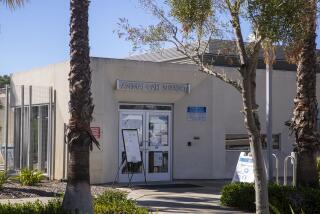Mishaps at nuke repository lead to $54 million in penalties
- Share via
New Mexico officials issued fines Saturday of $54 million against two contractors for errors in handling nuclear waste that led to a shutdown earlier this year of the nation’s only operating dump for nuclear weapons waste.
The fines come amid a growing frustration among state environmental regulators with errors and sloppy practices by U.S. Energy Department contractors that handle radioactive wastes. The cleanup schedules at nuclear weapons sites across the nation are decades behind schedule, and the New Mexico accident threatens to delay them further.
The state’s Environment Department found New Mexico-based Los Alamos National Laboratory had committed two dozen violations of rules and regulations related to the packaging of plutonium wastes that later erupted in the underground dump near Carlsbad, N.M.
The incident badly contaminated the repository, resulting in a shutdown that will probably last two years. The state issued a $36.6-million fine against the lab, which is operated by a consortium that includes San Francisco-based Bechtel and the University of California, among others.
The dump, formally known as the Waste Isolation Pilot Plant, was found responsible for 13 violations and fined $17.7 million.
The dump, where plutonium and other artificial elements are buried in ancient salt beds, is operated by San Francisco-based URS and Babcock and Wilcox. The violations include not only the release of radioactivity but a truck fire in the underground shaft just days before that caused significant smoke damage.
In a statement, the Environment Department said its findings “confirm the existence of major procedural problems that contributed to these events, and also found a less than adequate response.”
Gov. Susana Martinez, referring to the important economic role that the Energy Department plays in the state’s difficult economy, said she considered the federal agency a “strong partner,” but added, “The health and safety of New Mexicans will always be our priority and we have to hold federal agencies accountable for safe operations in the state of New Mexico.”
A recovery plan by the Energy Department has indicated that the February accidents will keep the dump closed for two years, backing up waste shipments from cleanup sites at shuttered nuclear weapons plants. A Los Angeles Times analysis earlier this year indicated that the cost of the accident could amount to $1 billion.
Last week, the Project on Government Oversight and Nuclear Watch New Mexico, two organizations that closely monitor the Energy Department, said in a letter to Energy Secretary Ernest Moniz that the consortium operating the Los Alamos lab should have its profits “slashed” because of substandard performance. The two groups noted that the contractor could earn fees of up to $57 million for the fiscal year that ended in September.
“In the face of these debacles, DOE should be seeking restitution, not providing a performance bonus,” said Peter Stockton, POGO’s senior investigator.
New Mexico officials said the two contractors could not pay for the fines out of federal funds that were marked for environmental cleanup or operational needs at the two facilities in the state. But whether the two contractors can bill the Energy Department or deduct them from taxes is not clear.
Don Hancock, director of the nuclear waste program at the environmental watchdog group Southwest Research and Information Center, said the two contractors probably have insurance that could cover the accident, but that in any case the Energy Department should not allow the companies to bill the government for the fines.
“I actually think that except that the companies are ‘too big to lose,’ their contracts at LANL and WIPP should be terminated because of their extremely unacceptable performance,” Hancock said.
Twitter: [email protected]
More to Read
Sign up for Essential California
The most important California stories and recommendations in your inbox every morning.
You may occasionally receive promotional content from the Los Angeles Times.











